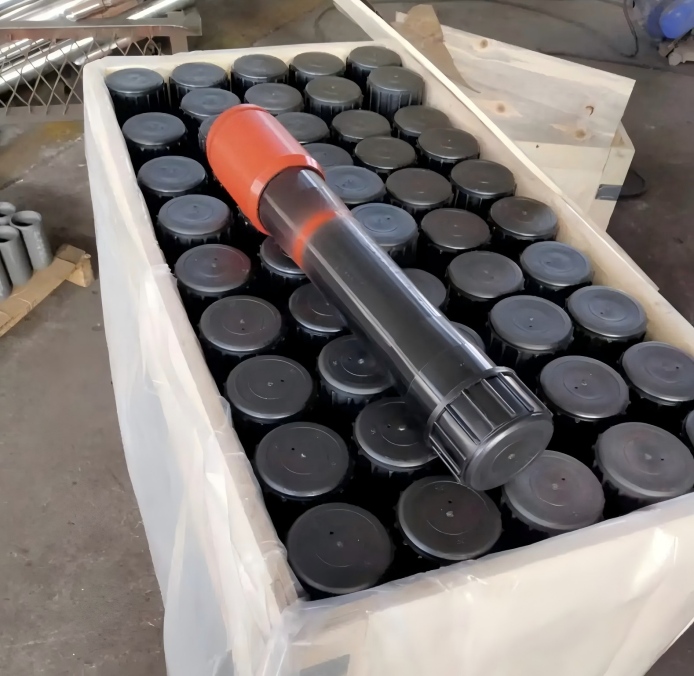Blast Joint
What is Blast Joint?
Blast Joint is a specially hardened, often thicker-walled section of tubing that is run as an integral part of the production string. It is strategically placed directly across from a perforated zone or a gas/water injection point.
What is its Purpose?
Its primary purpose is to protect the production tubing from direct, high-velocity, abrasive flow. Think of it as “armor plating” for your tubing.
Why is it Needed?
When reservoir fluids (oil, gas, water, often carrying sand) are produced, they jet through the perforations in the casing at very high velocities. If this high-energy, abrasive stream impinges directly on standard tubing, it will cause severe erosion, leading to a hole in the tubing string. This can cause a catastrophic failure, allowing fluids to flow into the wrong zones or to the surface uncontrollably.
- Scenario: You have a well with multiple producing zones. You want to produce from a lower zone but isolate an upper zone. The upper zone is perforated. The high-velocity flow from the lower zone would directly hit the tubing opposite the upper perforations. A blast joint is placed there to absorb this abuse.
Key Characteristics:
- Location: Placed across from perforations or fluid entry points.
- Material: Made of erosion-resistant materials (e.g., high-grade chromium steel) or has a thicker wall.
- Function: Erosion Protection.
Flow Coupling
What is Flow Coupling?
A Flow Coupling is a short, heavy-walled coupling (a threaded sleeve) that is installed on the tubing string immediately above and/or below a critical component that has a reduced internal diameter (ID).
What is its Purpose?
Its primary purpose is to manage fluid flow and prevent erosion caused by turbulence at points where the flow path changes abruptly.
Why is it Needed?
Downhole equipment like seating nipples, landing nipples, or profile locators have a smaller internal diameter than the main tubing. When fluid moving at high velocity hits this sudden restriction, it becomes turbulent and vortices form, creating a localized “washing” or “erosion” effect on the tubing wall just upstream and downstream of the restriction. Over time, this can wear away the tubing and cause failure.
- Scenario: You have a safety valve (a subsurface safety valve – SSSV) installed in your tubing string. The safety valve has a slightly smaller ID than the tubing. The flow coupling is installed above and below the safety valve to provide a smooth(er) transition area for the flow, dissipating the turbulent energy and protecting the more expensive and critical components.
Key Characteristics:
- Location: Placed adjacent to (above/below) flow restrictions (nipples, valves, etc.).
- Material: Same or similar material as the tubing, but with a much thicker wall.
- Function: Erosion and Turbulence Management.
The Difference
| Feature |
Blast Joint |
Flow Coupling |
| Primary Purpose | Erosion Protection from direct jetting | Turbulence Management & Erosion Prevention |
| Primary Cause of Damage | Direct impingement of high-velocity fluid | Turbulence from flow area changes (restrictions) |
| Location in Wellbore | Placed opposite perforations or fluid entry points. | Placed adjacent to (above/below) flow restrictions in the tubing string. |
| What it Protects | The tubing string itself. | The tubing and the critical component (e.g., safety valve) from washouts. |
| Physical Form | A joint of pipe (typically 10-40 ft). | A short, heavy-walled coupling (typically 1-2 ft). |
LANDRILL can provide Flow Coupling/Blast Joint, Welcome to inquire us
Size: 2 3/8″, 2 7/8″, 3 1/2″, 4 1/2″
Grade: K55, J55, N80, L80, P110 and L80 1%Cr , 9%Cr and 13%Cr
Connection:API Thread,Premium Thread,Blank end
Post time: Nov-05-2025










 Room 703 Building B, Greenland center, Hi-tech development zone Xi’an, China
Room 703 Building B, Greenland center, Hi-tech development zone Xi’an, China
 86-13609153141
86-13609153141


